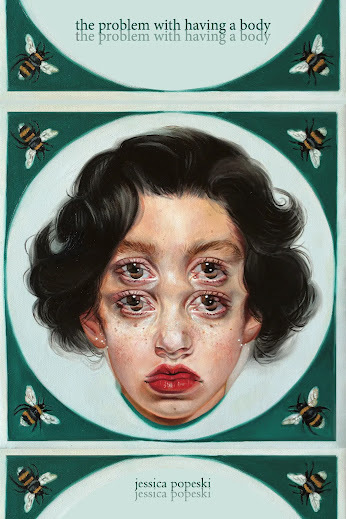Jessica Popeski, The Problem with Having a Body
iv
markham’s interlockingleaves
that tweenage hand trick
here’s the church here’sthe steeple
a sugar, norway, silver, emeraldqueen maple
and tulip, redmond linden,hackberry, horse chestnut
schubert chokecherrymarquee
a willow drizzles totarmac at harbord
the pong of a skunk feast
a block below bloor
candy cane spatter
meat fly-amassed
not supposed to bike buti bike
the way my body overburns
around ramhorn handles
nails tipped maroon shellac
all the rings are fallingfrom my fingers (“come clean”)
 Followingthe chapbooks The Wrong Place (Toronto ON: Anstruther Press, 2015) and Oratorio (Anstruther Press, 2015) [see my review of such here] comesToronto-based “dis/abled opera singer, Professor of English, Creative Writing,and Music, and internationally published, intersectional ecofeminist poet” Jessica Popeski’s full-length poetry debut,
The Problem with Having a Body
(GuelphON: Gordon Hill Press, 2025). As the back cover offers, this is a collection ofpoems “that unites Jessica Popeski’s preoccupations with intersectionalecofeminism, epigenetics, and the inheritance of fractured, grandmaternal generationallines. It reconciles private and public conflicts, examining how political andgeographical rupture and war zones generate traumatic, ancestral memory bychronicling experiences of moving through the world with dis/ability andanorexia. Accompanied by the insistence of matrilineal song, these poems askloud questions about cyclical bouts of anxiety and depression, madness, illness,voicelessness, and disordered eating.”
Followingthe chapbooks The Wrong Place (Toronto ON: Anstruther Press, 2015) and Oratorio (Anstruther Press, 2015) [see my review of such here] comesToronto-based “dis/abled opera singer, Professor of English, Creative Writing,and Music, and internationally published, intersectional ecofeminist poet” Jessica Popeski’s full-length poetry debut,
The Problem with Having a Body
(GuelphON: Gordon Hill Press, 2025). As the back cover offers, this is a collection ofpoems “that unites Jessica Popeski’s preoccupations with intersectionalecofeminism, epigenetics, and the inheritance of fractured, grandmaternal generationallines. It reconciles private and public conflicts, examining how political andgeographical rupture and war zones generate traumatic, ancestral memory bychronicling experiences of moving through the world with dis/ability andanorexia. Accompanied by the insistence of matrilineal song, these poems askloud questions about cyclical bouts of anxiety and depression, madness, illness,voicelessness, and disordered eating.” Thepoems in The Problem with Having a Body hold a precise measure ofdescriptive nuance; offering precise rhythm, hush, halt and flow. “when itrains it drizzles ceaselessly,” the short sequence “flatline” begins, “soeverything gets soaked / in my dreams i sleep / until six // ribs arescaffolding / stretch skin like cellophane / over leftovers [.]” Popeski writesthrough narratives of illness and the body, and matrilineal lines; of long-termdis/ability, wrapping her subject matter tight around the provocations of thebook’s title, and the title poem, that offers: “the problem with having a /body is you have to carry // it everywhere with you. / mine has held the curlicue/ of three babies & still // i’ve no one to show for it; / a hoard of manilamedical // files cramped & yellowing.”
Thecollection is structured in two sections, the bulk of which exists as “the prosand cons of staying sick,” followed by a far shorter section of more visually-focusedpoems, “sculptured,” akin to a kind of coda or punctuation. “this is how you /lose me.” she writes, to close the poem “this is how you lose me,” set in theopening section of the collection, “i won’t // eat for days, & / dream offolding // myself through / the tissuey air // of the humber / bay arch bridge.”That is such a lovely passage, that—“dream of folding // myself through / the tissueyair”—one of many that stopped me in my tracks, wanting to read it once more, abit slower. Hold on to that phrase, that image.
Thereis something curious about the way Popeski’s poems, specifically the morenarrative first-person lyrics of the opening section, seem to focus on themoments between occurrences, writing a kind of deceptive calm before the nextthing, the next event, or following what has already occurred. Her descriptivepassages write of movement, mid-gesture, offering layers of descriptivestraightforwardnesses that accumulate upon each other, but somehow end up somewhereother than the presumed sum of the poem’s parts. These are the poems that allowthe narrator the ability to hold it together through levels of uncertainty andillness. These are poem-markers, across a far broader narrative, not all of whichneeds to be seen to be understood. “the room in its semicircle,” the sequence “comeclean” ends, “sits up / a ruler-straight row / the youngest faces rose-redden /know this is what they have [.]”
Aswell, the poems in the book’s end-section shift from the narrative structuresof the pieces in the opening, instead offering grid-structures, building blocks,of words and phrases; poem-structures with titles “university health network,” “healthy,”“underweight,” “overweight,” “obese,” “extremely obese,” “muscle tension dysphonia/ false cards,” “krrrrrr,” “my oh my,” “nyay,” “kay” and “no.” There’s somethingof the Greek chorus to these poems, punctuating a number of the underlying subjectsthroughout the first section, providing something playful and serious to closeout. Utlizing the building blocks of shape, hashtag and repetition, the poem “obese,”reads, in full:
#pigout #sweettooth #foodcoma#cake
#pigout #sweettooth #foodcoma#cake #cook
#sweettooth #foodcoma #cake #cook
#sweettooth #foodcoma #cake #cook#fattofit
#sweettooth#foodcoma #cake #cook #fattofit
#sweettooth#foodcoma #cake #cook #fattofit



